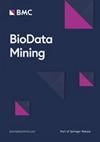利用化学靶标注释和基因表达预测分子起始事件
IF 4
3区 生物学
Q1 MATHEMATICAL & COMPUTATIONAL BIOLOGY
引用次数: 4
摘要
高通量转录组筛选技术的出现导致了大量与化学治疗相关的公开可用的基因表达数据。从监管的角度来看,涵盖大量化学空间并包含参考化学物质的数据集为预测与化学暴露相关的分子起始事件提供了实用工具。在这里,我们将来自化学暴露的转录组反应的大型汇编数据与化学-蛋白质关联的综合数据库相结合,以训练二元分类器,预测转录组反应的作用机制。首先,我们将LINCS L1000基因表达数据收集中的参考化学物质与RefChemDB(化学-蛋白质相互作用数据库)中的化学标识符联系起来。接下来,我们使用六种分类算法对MCF7人类乳腺癌细胞系衍生的基因表达谱和化学蛋白标签进行二元分类器训练,以确定最佳分析参数。为了验证分类器的准确性,我们使用了保留数据集,排除了训练的参考化学物质,并对来自排列化学-蛋白质关联的零模型进行了经验显著性检验。为了识别在来自不同细胞背景的训练数据中具有可变预测性能的分类器,我们在PC3人类前列腺癌细胞系上训练了一组单独的二元分类器。我们使用与51个分子起始事件相关的化学处理相关的表达数据来训练分类器。该分析鉴定并验证了9个高性能分类器,经验p值低于0.05,内部精度范围为0.73至0.94,持位精度范围为0.68至0.92。对排除训练的参考化学物质的高级预测表明,预测的准确性超出了分类器训练中使用的化学物质集。为了探索分类器性能作为训练数据细胞背景的差异,我们比较了mcf7训练的分类器与PC3基因表达数据训练的分类器在相同分子启动事件下的准确率。这种方法可以提供对目标筛选感兴趣的候选扰动原进行优先排序的见解。这种方法还可以帮助指导选择相关的细胞背景,使用细胞系特定模型性能筛选候选扰动原的类别。本文章由计算机程序翻译,如有差异,请以英文原文为准。
Predicting molecular initiating events using chemical target annotations and gene expression
The advent of high-throughput transcriptomic screening technologies has resulted in a wealth of publicly available gene expression data associated with chemical treatments. From a regulatory perspective, data sets that cover a large chemical space and contain reference chemicals offer utility for the prediction of molecular initiating events associated with chemical exposure. Here, we integrate data from a large compendium of transcriptomic responses to chemical exposure with a comprehensive database of chemical-protein associations to train binary classifiers that predict mechanism(s) of action from transcriptomic responses. First, we linked reference chemicals present in the LINCS L1000 gene expression data collection to chemical identifiers in RefChemDB, a database of chemical-protein interactions. Next, we trained binary classifiers on MCF7 human breast cancer cell line derived gene expression profiles and chemical-protein labels using six classification algorithms to identify optimal analysis parameters. To validate classifier accuracy, we used holdout data sets, training-excluded reference chemicals, and empirical significance testing of null models derived from permuted chemical-protein associations. To identify classifiers that have variable predicting performance across training data derived from different cellular contexts, we trained a separate set of binary classifiers on the PC3 human prostate cancer cell line. We trained classifiers using expression data associated with chemical treatments linked to 51 molecular initiating events. This analysis identified and validated 9 high-performing classifiers with empirical p-values lower than 0.05 and internal accuracies ranging from 0.73 to 0.94 and holdout accuracies of 0.68 to 0.92. High-ranking predictions for training-excluded reference chemicals demonstrating that predictive accuracy extends beyond the set of chemicals used in classifier training. To explore differences in classifier performance as a function of training data cellular context, MCF7-trained classifier accuracies were compared to classifiers trained on the PC3 gene expression data for the same molecular initiating events. This methodology can offer insight in prioritizing candidate perturbagens of interest for targeted screens. This approach can also help guide the selection of relevant cellular contexts for screening classes of candidate perturbagens using cell line specific model performance.
求助全文
通过发布文献求助,成功后即可免费获取论文全文。
去求助
来源期刊

Biodata Mining
MATHEMATICAL & COMPUTATIONAL BIOLOGY-
CiteScore
7.90
自引率
0.00%
发文量
28
审稿时长
23 weeks
期刊介绍:
BioData Mining is an open access, open peer-reviewed journal encompassing research on all aspects of data mining applied to high-dimensional biological and biomedical data, focusing on computational aspects of knowledge discovery from large-scale genetic, transcriptomic, genomic, proteomic, and metabolomic data.
Topical areas include, but are not limited to:
-Development, evaluation, and application of novel data mining and machine learning algorithms.
-Adaptation, evaluation, and application of traditional data mining and machine learning algorithms.
-Open-source software for the application of data mining and machine learning algorithms.
-Design, development and integration of databases, software and web services for the storage, management, retrieval, and analysis of data from large scale studies.
-Pre-processing, post-processing, modeling, and interpretation of data mining and machine learning results for biological interpretation and knowledge discovery.
 求助内容:
求助内容: 应助结果提醒方式:
应助结果提醒方式:


